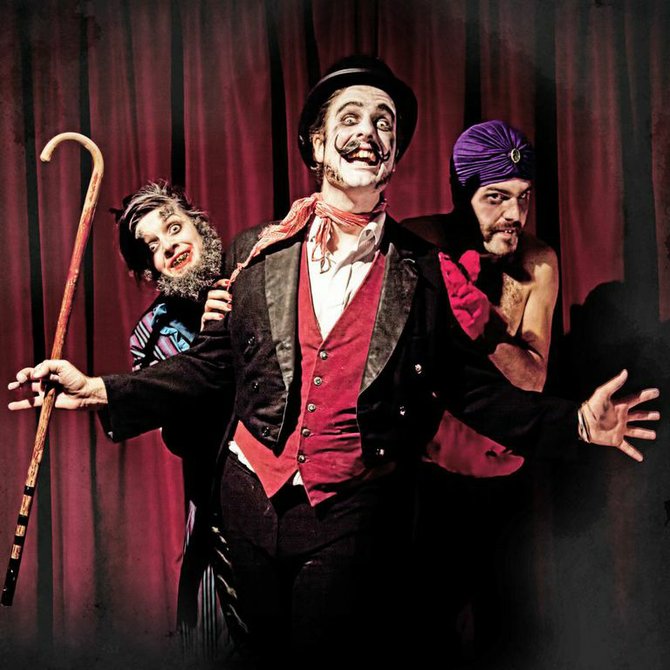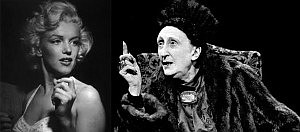 Facebook
Facebook
 X
X
 Instagram
Instagram
 TikTok
TikTok
 Youtube
Youtube

The Fringe’s “Off Broadway” space is the stage of the Spreckels Theatre. Tiers of folding chairs, their backs to the house seats, provide an intimate atmosphere.
Tin Shed, from the United Kingdom, presents an adaptation of Mary Shelley’s novel acted by “freaks.” The Master of Ceremonies, Julius M. Barker (Justin Cliffe) may be the biggest freak of all: a functionally insane sadist, he directs his cast like the Marquis de Sade at Charenton asylum, but with more vigor and brutality.
His “cast” includes Bethilda the Bearded Lady (Georgina Harris), who needs flickering electroshock treatment to get into character, Sangieve (Antonio Rimola), part-lobster, part-mind reader (who can read the mind of a lobster — or can he?), and The Monster (Aled Wyn-Thomas), who looks a lot like Dr. Frankenstein’s original, Until he speaks his speeches trippingly and swears he’s been miscast.
The piece, which has some lulls in pacing, is a kind of freako-centric tribute to Vaudeville. Enhanced by silhouettes on a rear curtain, the performers expertly bang into each other, mug clichéd expressions, and create oversized slapstick. And the show, ever about to fall apart (whence cometh much of the humor), goes on, prodded by the M.C.’s relentless cruelty (imagine Rocky Horror’s Dr. Frank N. Furter on meth).
What Tin Shed does may not appeal to all tastes. But they do what they do quite well.
Dame Edith Sitwell (1887-1964) blamed her “prickly” childhood, in part, on her parents. “They were too young when they married,” she told an interviewer in 1959, “and didn’t know anything about life.”
For that reason, she refused to attend her mother’s funeral.
She was six feet tall. Her look — head wrapped in a turban, long, dark velvet, Elizabethan-styled dresses, flaunted jewelry — became as recognizable as her experimental poetry. In all things, she was an outsider. Fiercely so.
In 1954, while touring Hollywood for a magazine article, her editors arranged a meeting with Sitwell’s exact opposite, he thought: Marilyn Monroe, Tinseltown’s reigning pin-up Venus. The editors assumed they’d hate each other on sight. Surely a catfight of Nietzchean proportions would ensue.

Not so. Sitwell detected a “strangely tragic” glint in her face “like a beautiful ghost.. and the vegetation spirit of Ophelia.”
Monroe was delighted to drop her image as a boulder-dumb ingénue and talk books and ideas. For half an hour, they chatted about the Austrian “anthro-philosopher” Rudolf Steiner.
The meeting’s a neat idea for a one-act play. Bring them on, break down barriers, set them free.
Bottomly’s script promises to show the real Sitwell “behind the shades” and Marilyn, too. But it’s a full, cover-to-cover rewrite away.
The director George Cukor is filming the meeting. For unknown reasons, Sitwell and Monroe are scripted. The piece takes too much time with this device: word choices, missing a line, rewriting. At one point, as if commenting on the text, Cukor says “let’s get this back on track.” He’s right, since the play rambles without a through-line.
It’s also predictable, and spouts time-worn clichés about Hollywood (“the studios are god”; “why can’t love be more like it is in the movies?”).
The performances are uneven. Loie Gail really looks like Sitwell, though she could trill her R’s less and be less external. Rhianna Basore really looks like Monroe, though her accent wavers toward French. Credit the accuracy to Mallory Devlin’s “costume alterations”: Sitwell a pillar of black velvet; Monroe all in white with high-grade platinum hair.


The Fringe’s “Off Broadway” space is the stage of the Spreckels Theatre. Tiers of folding chairs, their backs to the house seats, provide an intimate atmosphere.
Tin Shed, from the United Kingdom, presents an adaptation of Mary Shelley’s novel acted by “freaks.” The Master of Ceremonies, Julius M. Barker (Justin Cliffe) may be the biggest freak of all: a functionally insane sadist, he directs his cast like the Marquis de Sade at Charenton asylum, but with more vigor and brutality.
His “cast” includes Bethilda the Bearded Lady (Georgina Harris), who needs flickering electroshock treatment to get into character, Sangieve (Antonio Rimola), part-lobster, part-mind reader (who can read the mind of a lobster — or can he?), and The Monster (Aled Wyn-Thomas), who looks a lot like Dr. Frankenstein’s original, Until he speaks his speeches trippingly and swears he’s been miscast.
The piece, which has some lulls in pacing, is a kind of freako-centric tribute to Vaudeville. Enhanced by silhouettes on a rear curtain, the performers expertly bang into each other, mug clichéd expressions, and create oversized slapstick. And the show, ever about to fall apart (whence cometh much of the humor), goes on, prodded by the M.C.’s relentless cruelty (imagine Rocky Horror’s Dr. Frank N. Furter on meth).
What Tin Shed does may not appeal to all tastes. But they do what they do quite well.
Dame Edith Sitwell (1887-1964) blamed her “prickly” childhood, in part, on her parents. “They were too young when they married,” she told an interviewer in 1959, “and didn’t know anything about life.”
For that reason, she refused to attend her mother’s funeral.
She was six feet tall. Her look — head wrapped in a turban, long, dark velvet, Elizabethan-styled dresses, flaunted jewelry — became as recognizable as her experimental poetry. In all things, she was an outsider. Fiercely so.
In 1954, while touring Hollywood for a magazine article, her editors arranged a meeting with Sitwell’s exact opposite, he thought: Marilyn Monroe, Tinseltown’s reigning pin-up Venus. The editors assumed they’d hate each other on sight. Surely a catfight of Nietzchean proportions would ensue.

Not so. Sitwell detected a “strangely tragic” glint in her face “like a beautiful ghost.. and the vegetation spirit of Ophelia.”
Monroe was delighted to drop her image as a boulder-dumb ingénue and talk books and ideas. For half an hour, they chatted about the Austrian “anthro-philosopher” Rudolf Steiner.
The meeting’s a neat idea for a one-act play. Bring them on, break down barriers, set them free.
Bottomly’s script promises to show the real Sitwell “behind the shades” and Marilyn, too. But it’s a full, cover-to-cover rewrite away.
The director George Cukor is filming the meeting. For unknown reasons, Sitwell and Monroe are scripted. The piece takes too much time with this device: word choices, missing a line, rewriting. At one point, as if commenting on the text, Cukor says “let’s get this back on track.” He’s right, since the play rambles without a through-line.
It’s also predictable, and spouts time-worn clichés about Hollywood (“the studios are god”; “why can’t love be more like it is in the movies?”).
The performances are uneven. Loie Gail really looks like Sitwell, though she could trill her R’s less and be less external. Rhianna Basore really looks like Monroe, though her accent wavers toward French. Credit the accuracy to Mallory Devlin’s “costume alterations”: Sitwell a pillar of black velvet; Monroe all in white with high-grade platinum hair.
Comments